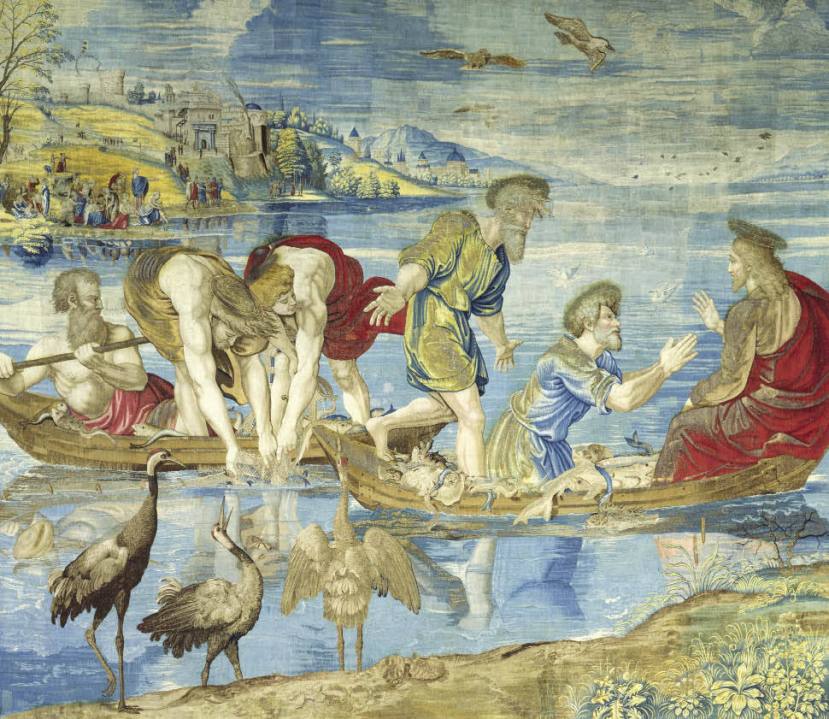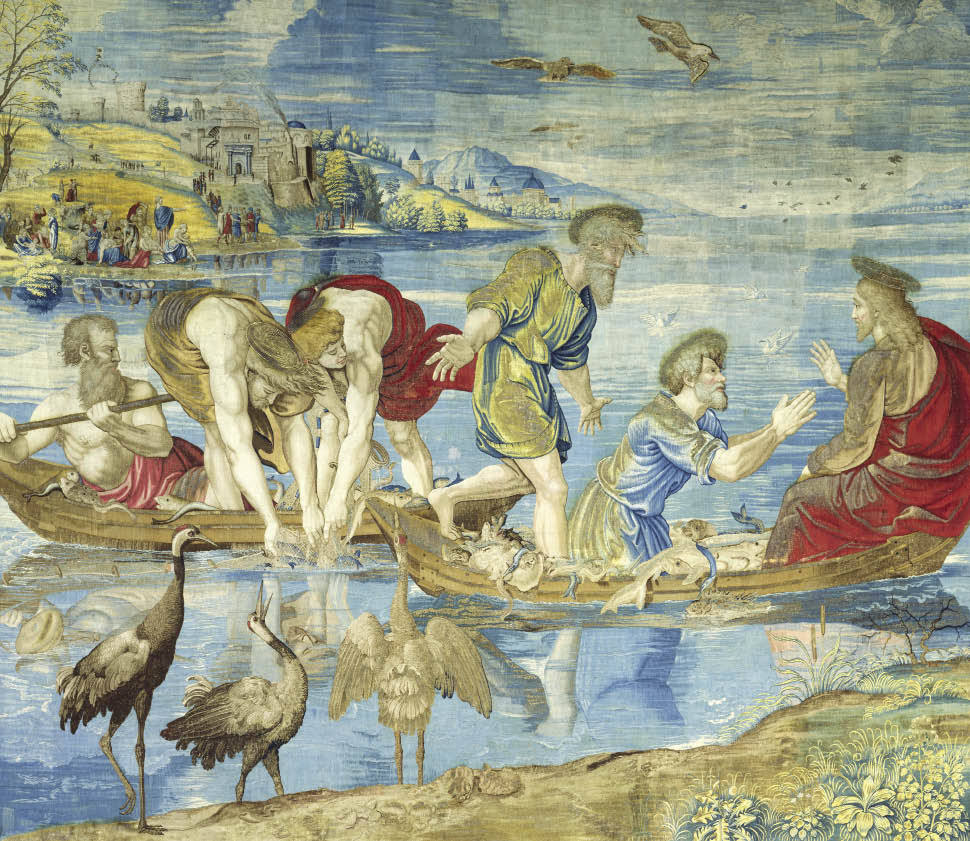We tend to take for granted the fact that the V&A houses one of the great wonders of the Italian High Renaissance: Raphael’s remarkable tapestry cartoons celebrating the lives of St Peter and St Paul.
We tend to take for granted the fact that the V&A houses one of the great wonders of the Italian High Renaissance: Raphael’s remarkable tapestry cartoons celebrating the lives of St Peter and St Paul. These tapestries were designed for the Sistine Chapel to be hung around the lowest tier of the walls on ceremonial occasions, and thus had to complement (if not compete with) Michelangelo’s awesome ceiling decoration. Raphael excelled himself in the inventiveness of these works — they are masterpieces of succinct harmonious design, and feel so right and natural in their depictions that their imagery has subtly influenced the way we visualise biblical characters. To celebrate the Pope’s visit to England, four of the original tapestries are being lent to the V&A by the Vatican Museums. This will be the first time the tapestries have been reunited with the cartoons since they were woven in Brussels.
The surviving seven of the original ten cartoons commissioned by Pope Leo X have been part of the Royal Collection in England since Charles I bought them in 1623, while still Prince of Wales. In 1865, Queen Victoria gave them on long loan to what was then the South Kensington Museum, and they’ve been in the V&A ever since, too fragile to be moved. They are, after all, working drawings, which had to be cut up into vertical strips so that the weavers could accurately follow their designs. The weaving method required that the image be reversed, so Raphael also had to think out his schemes back to front. (The same approach is adopted by printmakers, so it’s not such an unusual proceeding.) Looking at the cartoons now, we have to reverse them mentally to experience the effects that Raphael was after, so to have some of the tapestries to compare them with is a marvellous opportunity to see the images as they should be.
The cartoons themselves are not easy to see, being hung high on the wall and requiring much distance-viewing and neck-stretching. Nevertheless, it’s remarkable that they have survived in such good condition, considering the inevitable rough treatment they were subjected to. (There were several sets of tapestries made from them in the 16th century, and a dozen more at Mortlake in the 17th century after they were brought to England.) It would be a revelation to have them reglazed with non-reflective museum glass, but perhaps they are too delicate even to disturb that much, never mind the cost. There has been a certain amount of wrinkling and fading — the red lake vegetable dye has disappeared entirely from Christ’s robe in ‘The Miraculous Draught of Fishes’, though it’s still there in the reflection — but the colour remains magnificently subtle. These are works of considerable genius.
A painted terracotta head of Pope Leo when he was still Cardinal Giovanni de’ Medici greets the visitor. To the right is the tapestry of ‘Christ’s Charge to Peter’, and at right angles and in front is the cartoon for it. To the left are a couple of detached tapestry borders on the themes of The Four Seasons and The Hours. To the left of the doorway are ‘The Healing of the Lame Man’, cartoon and tapestry, and ‘The Sacrifice at Lystra’, in a similar pairing.
The tapestry version of ‘The Lame Man’ is oddly sanitised, the realism of the flesh colours in the cartoon having been bleached out, and masses of metal thread woven into the columns. The image is dominated by these barley-twist columns, and in the cartoon the fall of light on their surfaces is dramatically and brilliantly captured. In the tapestry the metal thread reduces the columns to uniformity, and they look like shimmering metal disco poles. But one should not expect literal translation. After all, the tapestry process involves a reinterpretation, from one medium to another, with a different set of requirements and effects.
Down in the far-left corner, and rather neglected when I was there (there are no tapestries hereabouts), is one of the greatest of the cartoons — ‘The Death of Ananias’. The distinguished scholar John White described it as ‘amongst the most grandly calm and the most classical of Raphael’s mature compositions’. The breadth of individuation and psychological penetration here is equalled only by the moments of tension resolved into harmony of the compositional flow. Also at this end of the room are a number of engravings and woodcuts done after the designs, showing how their imagery travelled the world and became widely familiar.
Meanwhile, on the far right of the gallery we are given the chance to compare the cartoon of ‘The Miraculous Draught’ with the Sistine tapestry and a later Mortlake one. The Vatican hanging is brighter and altogether more vibrant, with its sepia-bronze predella panel making it appear more vertical in composition. The Mortlake tapestry appears dimmer (but it is also less well lit) and more sub-aqueous in palette.
As a general rule, the tapestries lose in subtlety but gain in decorative grandeur. Look, for example, at the foreground vegetation in ‘The Miraculous Draught’. It is much more prominent in the tapestry than in the cartoon, simply because it offered a chance for the weavers to show off their dexterity. How boring and restrictive must it be for a skilled craftsman to follow slavishly another’s instructions? The urge to deviate, invent or simply change (always no doubt under the mistaken assumption that change is for the better) must be for some of the more creative difficult to resist. And it’s clear from studying and comparing cartoons with tapestries that a number of changes were instituted, with or without the artist’s permission.
One of the most substantial changes is in ‘Christ’s Charge’, where His white robe has been beautifully adorned with bursting golden stars. Also Peter’s cloak has been changed from yellow to red, and a strip of vegetation added, separating the heads of the Apostles from the landscape behind. However, one of the most striking departures is in the depiction of the Saints’ haloes, which are far more emphasised in the tapestry and make a much stronger visual rhythm across the surface. Occasionally interlacing, and moving from the circular to the oval through a variety of shapes, this has become a marvellous abstract pattern.
The cartoons will be there for future study (one hopes and trusts) but the tapestries leave soon, so an early visit is recommended. All are worth a long look, though the finest is undoubtedly ‘Christ’s Charge’, which is splendidly impressive. Next comes ‘The Miraculous Draft’. ‘The Lame Man’ is overwhelmed, I think, by the columns, which work so much better in the cartoon. And ‘The Sacrifice’ is just slightly caricatural in its drawing, even though it is meant to be read at a distance.
This was a heartening show to linger in: visitors were happily looking at art with concentrated attention. Encouraging people to compare and contrast is an effective way of involving them, and helps to overcome the unease or boredom often felt in museums. When I went, there were lots of people in the gallery, though the big space easily absorbed them and timed entry prevents a crush. Admission is free, but you do have to have a ticket, and there can be queues. A small but beautifully produced hardback accompanies the show (£14.99), which illustrates the cartoons and all ten of the tapestries and explores their history, making and influence in some detail. Fascinating.







Comments